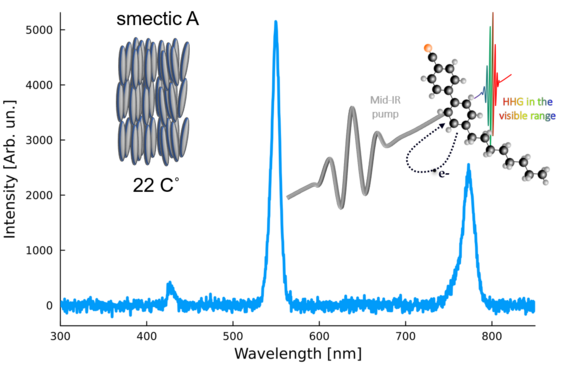Investigation of ultrafast dynamics: High harmonic generation (HHG)
To better understand the ultrafast behavior of liquid crystals (LCs), we are using High Harmonic Generation (HHG)—a nonlinear optical technique that allows us to track molecular and electronic changes with femtosecond resolution. This approach gives us the ability to study dynamic processes in soft matter systems as they happen, in real time.
What is High Harmonic Generation?
HHG involves generating high-frequency photons, typically in the extreme ultraviolet (EUV) to soft X-ray range, by directing intense, ultrashort laser pulses into a nonlinear medium. A key advantage of HHG is that the same laser pulse that initiates the dynamics also probes the system, allowing us to observe energy redistribution, electronic reorganization, and molecular motion simultaneously.
Although HHG has been extensively studied in gases and, more recently, in solids and nanostructures, its application to liquids and soft materials remains relatively unexplored. We see liquid crystals as an ideal platform to bridge this gap. Because LCs exhibit both fluidity and structural order, we can explore how light interacts with materials that have tunable anisotropy, molecular mobility, and collective behavior. This makes LCs uniquely suited for investigating light–matter interactions in a regime where order and flexibility coexist.
Probing local order with high harmonic generation
We are finding that HHG is highly sensitive to the local symmetry and electronic structure of liquid crystals. This sensitivity enables us to probe how molecular orientation and intermolecular interactions evolve across different LC mesophases—such as nematic, smectic, and isotropic states. Each phase is characterized by distinct optical anisotropies and levels of orientational order, which are reflected in the HHG signal.
By analyzing changes in HHG spectra, we can monitor how phase transitions affect harmonic generation. For example, when the system transitions from a nematic to a smectic phase, we observe changes in harmonic intensity and polarization that reflect increased positional order and altered molecular alignment. Because HHG responds strongly to symmetry breaking and polarization effects, it serves as a precise and non-invasive method for detecting subtle structural changes.

Controlling high harmonic generation through external stimuli
What makes LCs particularly exciting for us is their responsiveness to external stimuli. We can manipulate their phase and molecular alignment using electric or magnetic fields, giving us dynamic control over the HHG process. This capability allows us to tune the spectral and polarization properties of the emitted harmonics on demand.
With femtosecond time resolution and nanoscale spatial sensitivity, HHG enables us to directly observe how the internal structure of LCs evolves under various conditions. This helps us build a deeper understanding of soft condensed matter and how molecular organization governs material response.
Through our work, we are establishing HHG as a powerful tool for studying the ultrafast dynamics of liquid crystals. Its sensitivity to molecular symmetry, phase transitions, and local order provides a unique window into soft matter systems at the atomic and molecular scale. By examining how HHG spectra shift with structural changes, we are uncovering new insights into the behavior of LCs and opening pathways for real-time optical control in adaptive materials.


